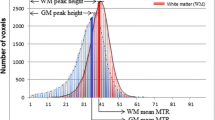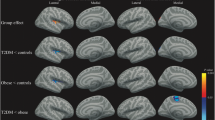Abstract
Risk factors for the metabolic syndrome (MetS) affect brain function and associate with asymptomatic brain infarctions in healthy individuals. We studied whether MetS risk factors alter cerebral metabolism. Eighteen non-smoking men (36 ± 6years) were stratified into two groups according to their risk of developing the MetS. Individuals in the Risk group had a family history of type 2 diabetes, were pre-obese, had mild hypertension and higher fasting plasma glucose and serum insulin compared to the Control group with no risk factors. N-acetyl aspartate, choline, total creatine (tCr), myo-inositol, and glucose were studied in the thalamus, frontal cortex, and frontal white matter with proton magnetic resonance spectroscopy. The plasma glucose was 13% higher (p < 0.01) in the Risk group, but the brain glucose levels were comparable between the groups. In the Control group, the thalamic tCr correlated with the thalamic glucose level (r = 0.81, p = 0.015). In the Risk group, the tCr was 17% higher (p = 0.006) and correlated with the fasting plasma glucose concentration (r = 0.78, p = 0.013), but not with the thalamic glucose level. In conclusion, the increased tCr level in the Risk group suggests that a family history of type 2 diabetes together with MetS risk factors alters thalamic energy metabolism.



Similar content being viewed by others
References
Alberti KG, Zimmet P, Shaw J (2006) Metabolic syndrome—a new world-wide definition. A consensus statement from the International Diabetes Federation. Diabet Med 23:469–480
Arenillas JF, Moro MA, Davalos A (2007) The metabolic syndrome and stroke: potential treatment approaches. Stroke 38:2196–2203
Baslow MH (2003) N-acetylaspartate in the vertebrate brain: metabolism and function. Neurochem Res 28:941–953
Brosnan JT, Brosnan ME (2007) Creatine: endogenous metabolite, dietary, and therapeutic supplement. Annu Rev Nutr 27:241–261
Catani M, Mecocci P, Tarducci R, Howard R, Pelliccioli GP, Mariani E, Metastasio A, Benedetti C, Senin U, Cherubini A (2002) Proton magnetic resonance spectroscopy reveals similar white matter biochemical changes in patients with chronic hypertension and early Alzheimer's disease. J Am Geriatr Soc 50:1707–1710
de Graaf RA, Pan JW, Telang F, Lee JH, Brown P, Novotny EJ, Hetherington HP, Rothman DL (2001) Differentiation of glucose transport in human brain gray and white matter. J Cereb Blood Flow Metab 21:483–492
de Leeuw FE, de Groot JC, Oudkerk M, Witteman JC, Hofman A, van Gijn J, Breteler MM (2002) Hypertension and cerebral white matter lesions in a prospective cohort study. Brain 125:765–772
DeCarli C, Miller BL, Swan GE, Reed T, Wolf PA, Garner J, Jack L, Carmelli D (1999) Predictors of brain morphology for the men of the NHLBI twin study. Stroke 30:529–536
Gujar SK, Maheshwari S, Bjorkman-Burtscher I, Sundgren PC (2005) Magnetic resonance spectroscopy. J Neuro-ophthalmol 25:217–226
Heilig CW, Stromski ME, Blumenfeld JD, Lee JP, Gullans SR (1989) Characterization of the major brain osmolytes that accumulate in salt-loaded rats. Am J Physiol 257:F1108–F1116
Kwon HM, Kim BJ, Lee SH, Choi SH, Oh BH, Yoon BW (2006) Metabolic syndrome as an independent risk factor of silent brain infarction in healthy people. Stroke 37:466–470
Laaksonen DE, Niskanen L, Nyyssönen K, Punnonen K, Tuomainen TP, Salonen JT (2005) C-reactive protein in the prediction of cardiovascular and overall mortality in middle-aged men: a population-based cohort study. Eur Heart J 26:1783–1789
Maheshwari SR, Fatterpekar GM, Castillo M, Mukherji SK (2000) Proton MR spectroscopy of the brain. Semin Ultrasound CT MR 21:434–451
Mäkimattila S, Malmberg-Ceder K, Häkkinen AM, Vuori K, Salonen O, Summanen P, Yki-Järvinen H, Kaste M, Heikkinen S, Lundbom N, Roine RO (2004) Brain metabolic alterations in patients with type 1 diabetes–hyperglycemia-induced injury. J Cereb Blood Flow Metab 24:1393–1399
Manschot SM, Biessels GJ, de Valk H, Algra A, Rutten GE, van der Grond J, Kappelle LJ, on behalf of the Utrecht Diabetic Encephalopathy Study Group (2007) Metabolic and vascular determinants of impaired cognitive performance and abnormalities on brain magnetic resonance imaging in patients with type 2 diabetes. Diabetologia 50:2388–2397
Mason GF, Pan JW, Chu WJ, Newcomer BR, Zhang Y, Orr R, Hetherington HP (1999) Measurement of the tricarboxylic acid cycle rate in human grey and white matter in vivo by 1H-[13C] magnetic resonance spectroscopy at 4.1T. J Cereb Blood Flow Metab 19:1179–1188
Meigs JB, Cupples LA, Wilson PW (2000) Parental transmission of type 2 diabetes: the Framingham Offspring Study. Diabetes 49:2201–2207
Moffett JR, Ross B, Arun P, Madhavarao CN, Namboodiri AM (2007) N-acetylaspartate in the CNS: from neurodiagnostics to neurobiology. Prog Neurobiol 81:89–131
Najarian RM, Sullivan LM, Kannel WB, Wilson PW, D'Agostino RB, Wolf PA (2006) Metabolic syndrome compared with type 2 diabetes mellitus as a risk factor for stroke: the Framingham Offspring Study. Arch Intern Med 166:106–111
Ohtsuki S, Tachikawa M, Takanaga H, Shimizu H, Watanabe M, Hosova K, Terasaki T (2002) The blood-brain barrier creatine transporter is a major pathway for supplying creatine to the brain. J Cereb Blood Flow Metab 22:1327–1335
Pouwels PJ, Brockmann K, Kruse B, Wilken B, Wick M, Hanefeld F, Frahm J (1999) Regional age dependence of human brain metabolites from infancy to adulthood as detected by quantitative localized proton MRS. Pediatr Res 46:474–485
Prichard JW, Alger JR, Behar KL, Petroff OA, Shulman RG (1983) Cerebral metabolic studies in vivo by 31P NMR. Proc Natl Acad Sci U S A 80:2748–2751
Ross B, Bluml S (2001) Magnetic resonance spectroscopy of the human brain. Anat Rec 265:54–84
Seaquist ER, Damberg GS, Tkac I, Gruetter R (2001) The effect of insulin on in vivo cerebral glucose concentrations and rates of glucose transport/metabolism in humans. Diabetes 50:2203–2209
Sinha S, Misra A, Kumar V, Jagannathan NR, Bal CS, Pandey RM, Singhania R, Deepak (2004) Proton magnetic resonance spectroscopy and single photon emission computed tomography study of the brain in asymptomatic young hyperlipidaemic Asian Indians in North India show early abnormalities. Clin Endocrinol (Oxf) 61:182–189
Stern MP, Williams K, Gonzalez-Villalpando C, Hunt KJ, Haffner SM (2004) Does the metabolic syndrome improve identification of individuals at risk of type 2 diabetes and/or cardiovascular disease? Diabetes Care 27:2676–2681
van Dijk EJ, Prins ND, Vermeer SE, Vrooman HA, Hofman A, Koudstaal PJ, Breteler MM (2005) C-reactive protein and cerebral small-vessel disease: the Rotterdam Scan Study. Circulation 112:900–905
Wolf PA, Beiser A, Elias MF, Au R, Vasan RS, Seshadri S (2007) Relation of obesity to cognitive function: importance of central obesity and synergistic influence of concomitant hypertension. The Framingham Heart Study. Curr Alzheimer Res 4:111–116
Yudkin JS (1999) Abnormalities of coagulation and fibrinolysis in insulin resistance. Evidence for a common antecedent? Diabetes Care 22(Suppl 3):C25–C30
Virtanen KA, Hirvonen J, Bucci M, Honka M, Nesterov S, Iozzo P, Rinne OJ, Nuutila P (2007) Insulin-stimulated brain glucose uptake is enhanced in subjects with impaired glucose tolerance (IGT). Diabetologia 50(Suppl 1):A0017 (Abstract)
Acknowledgements
Financial support was provided by grants from Folkhälsan Research Foundation, Finnish Medical Society (Finska Läkaresällskapet), a special governmental grant for health sciences research (no. 5103), Diabetes Research Foundation, Waldemar von Frenckell’s Foundation and Wilhelm and Else Stockmann Foundation.
Author information
Authors and Affiliations
Corresponding author
Rights and permissions
About this article
Cite this article
Heikkilä, O., Lundbom, N., Timonen, M. et al. Risk for metabolic syndrome predisposes to alterations in the thalamic metabolism. Metab Brain Dis 23, 315–324 (2008). https://doi.org/10.1007/s11011-008-9094-5
Received:
Accepted:
Published:
Issue Date:
DOI: https://doi.org/10.1007/s11011-008-9094-5




